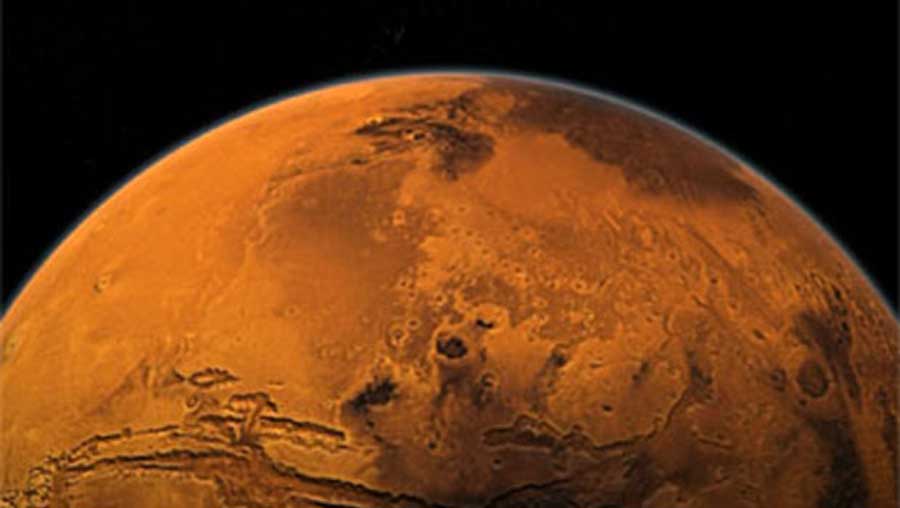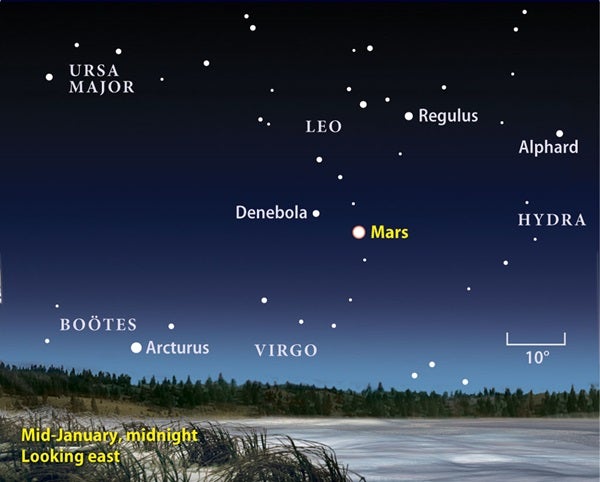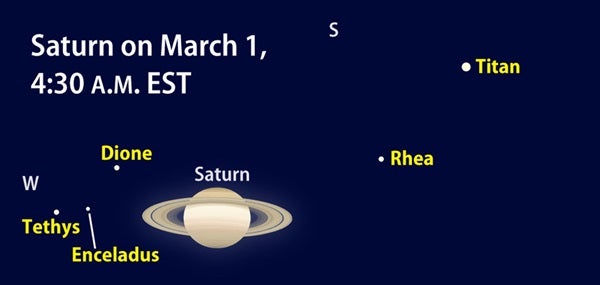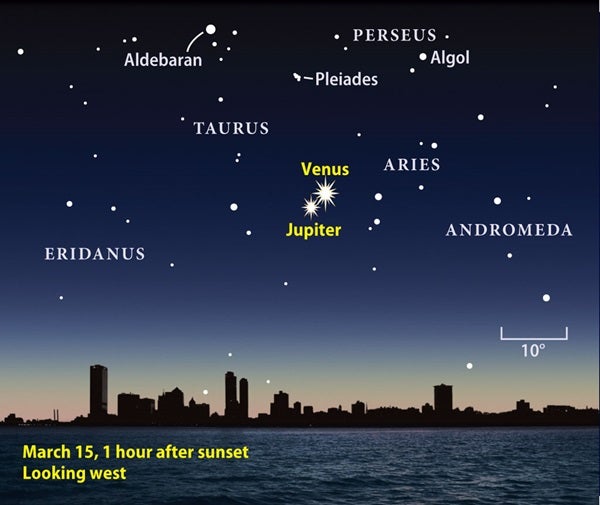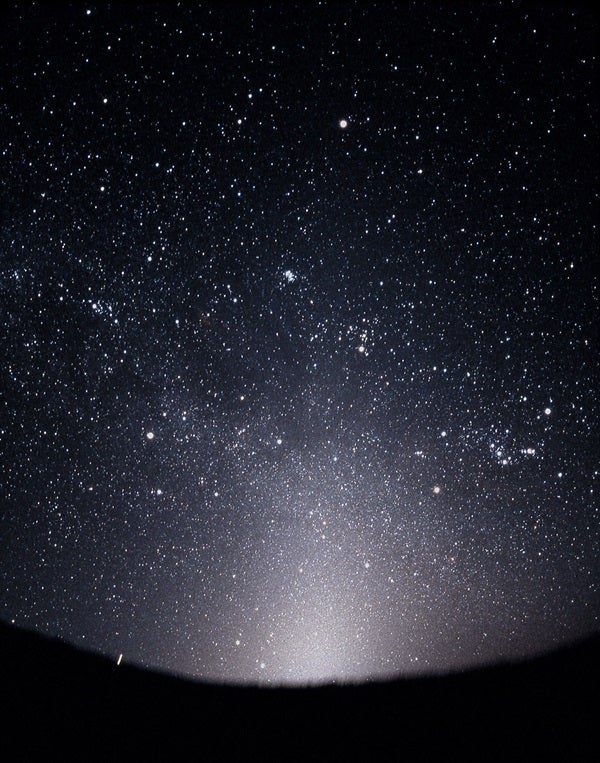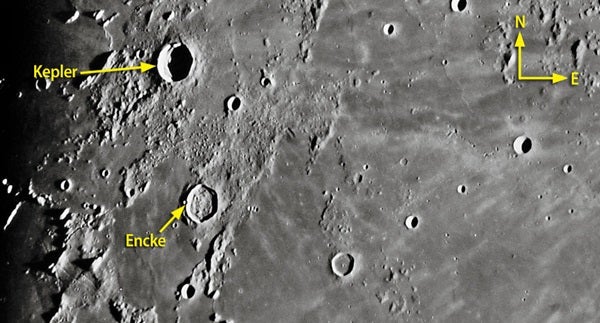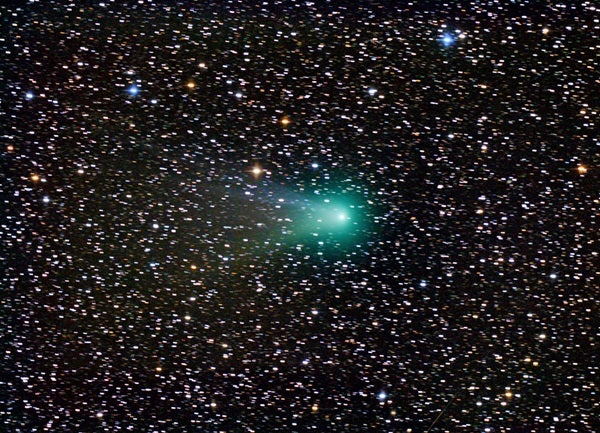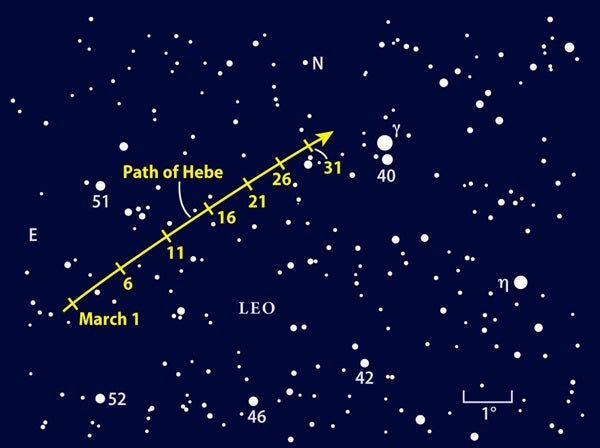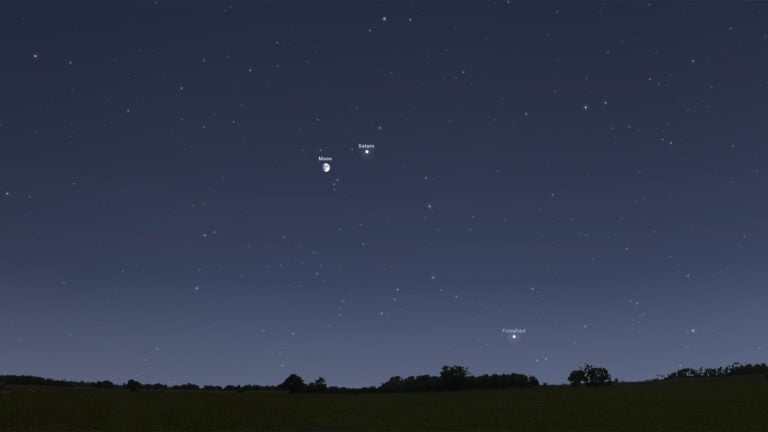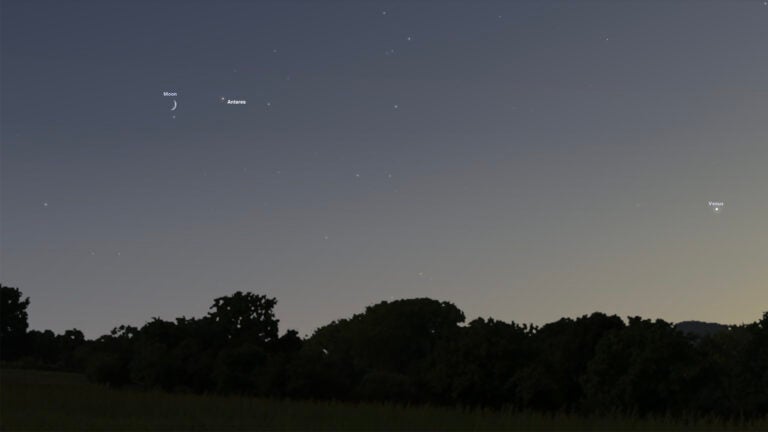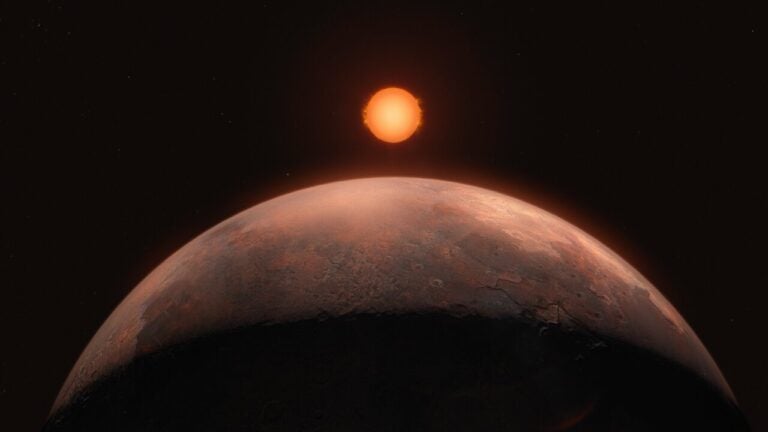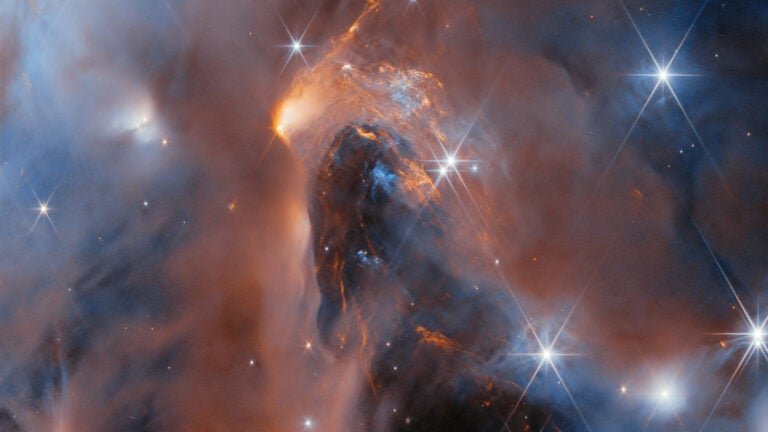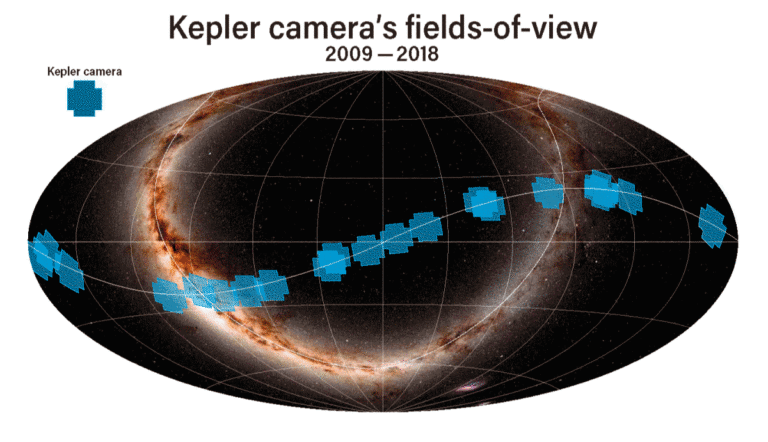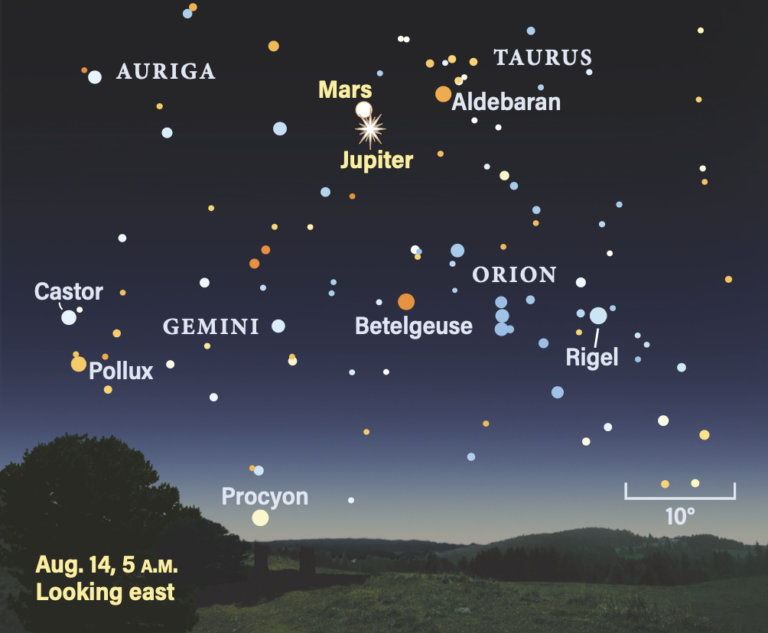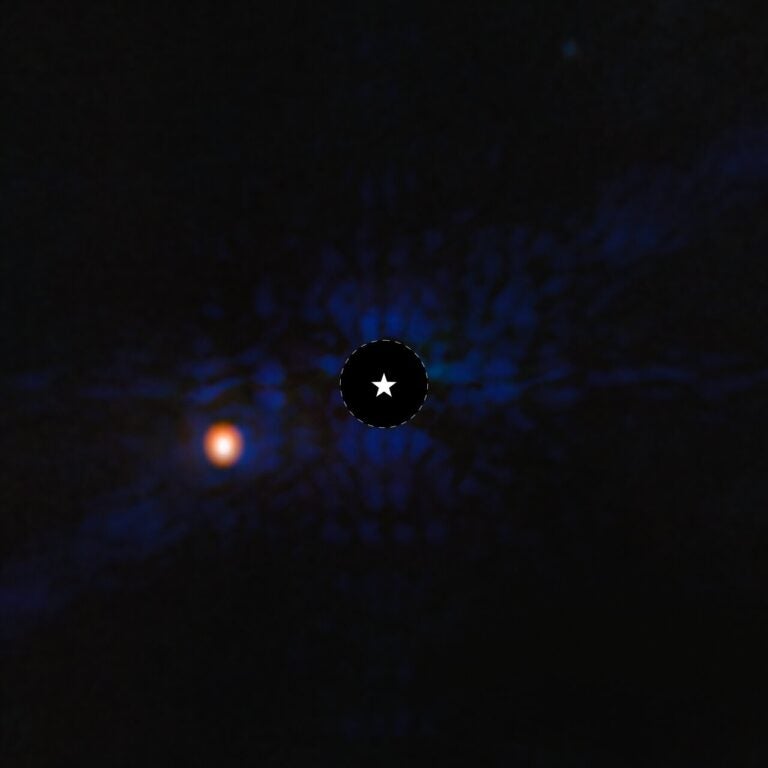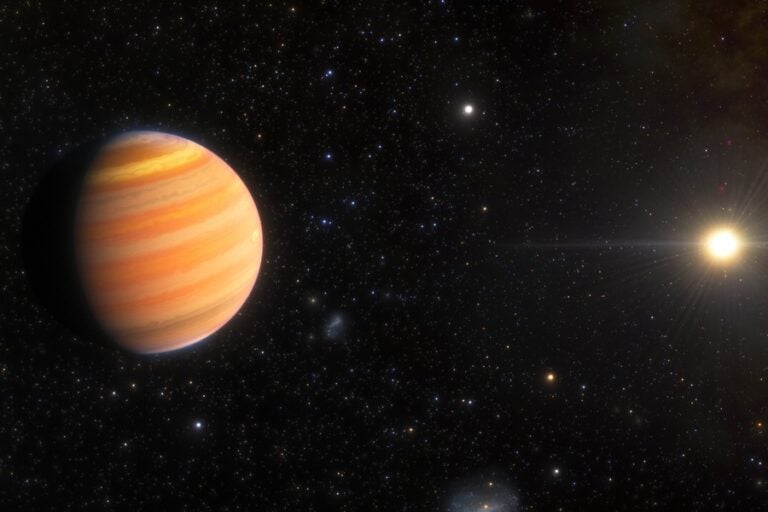The opposite part of the sky witnesses its own drama as Mars arrives at opposition and peak visibility. It ranks number four on the brightness scale this month, with only two brighter planets and the star Sirius beating it. And if that isn’t enough, gorgeous Saturn brightens as it approaches its April opposition.
Let’s begin our tour low in the western sky shortly after the Sun goes down. Mercury is on prime view during March’s first week. The innermost planet reaches greatest eastern elongation March 5, when it lies 18° east of the Sun. For an observer at 40° north latitude, the planet stands 11° above the horizon
30 minutes after sunset and sets an hour later.
Mercury shines at magnitude –0.4, easily bright enough to pierce the twilight glow. A view through a telescope reveals the planet’s 7″-diameter, half-lit disk. The most impressive aspect of Mercury’s telescopic face is its rapidly changing phase. On March 1, the disk appears two-thirds lit. By the 10th, only one-quarter of the planet is illuminated. Mercury disappears in the Sun’s glow soon thereafter, passing between Earth and our star on the 21st.
Mercury appears near Uranus in early March. On the 1st, the distant world lies 4° to Mercury’s upper left. You’ll be hard-pressed to see 6th-magnitude Uranus in twilight, however. Your best bet is to use a go-to telescope and wait until the sky darkens considerably. You have a narrow window to view the planet because it sets just 105 minutes after the Sun.
Venus reaches its greatest elongation March 27, when it stands 46° to the Sun’s east. It lies high in the west after darkness falls thanks to the position of the ecliptic — the apparent path of the Sun across the sky that the planets follow closely. In early spring, the ecliptic makes a steep angle to the western horizon after sunset, so a planet’s angular separation from the Sun translates mostly into altitude.
Venus spends the first three days of March in eastern Pisces before crossing into Aries on the 4th. The planet then lies 9° due west of Jupiter. The gap between the planets continues to narrow, and, between March 11 and 15, they lie 3° from each other. (The two are officially in conjunction, when Venus passes due north of Jupiter, before dawn on the 15th.)
Although conjunctions between Jupiter and Venus occur at regular intervals, few occur as high in the sky as this year’s. The next conjunction comes May 28, 2013, when the two lie 16° from the Sun. A July 1, 2015, event happens with both planets 42° from the Sun, but the ecliptic makes a shallow angle to the horizon then, so the two appear only half as high to Northern Hemisphere observers as they do this month. The next conjunction that rivals this one occurs before dawn October 26, 2015.
The best views of the Venus-Jupiter conjunction will come with naked eyes or through binoculars. But individually, both planets make worthy telescopic targets during March. Venus starts the month with a 19″-diameter disk that exhibits a gibbous phase (63 percent lit). The disk’s size grows while the phase diminishes all month. Any scope will reveal what looks like a tiny, pearly white First Quarter Moon March 29. Venus then shows a half-lit disk that spans 24″.
The end of March offers some dynamic binocular views of Venus to compete with those during the Jupiter conjunction. On the evening of the 26th, watch a waxing crescent Moon pass 2° from the brilliant planet. And by the 31st, Venus stands 3° below the bright Pleiades star cluster (M45) in Taurus. The planet will pass in front of the cluster April 2 and 3.
Jupiter displays a fine contrast to Venus. The giant planet sports abundant cloud features that show up through any telescope; Venus exhibits a bland cloud deck. And with an equatorial diameter of 35″ in mid-March, Jupiter appears two-thirds larger than its neighbor in southern Aries.
The best time to view the gas giant comes during late twilight and in the first hour after darkness falls, when it lies higher in the sky and its light traverses less of Earth’s turbulent atmosphere. The planet’s disk reveals two dark equatorial belts sandwiched around a brighter equatorial zone. Subtler features border the belts.
Shadow transits are the most visually compelling observations. A dark shadow stands out so well against the bright jovian clouds that you can see it even through a small telescope.
The evening of March 22 offers North American observers two such events with nearly an hour of overlap between them. Io’s shadow first touches the cloud tops at 9:22 p.m. EDT, and Ganymede’s joins it at 10:35 p.m. EDT. Io’s dark dot lifts back into space at 11:31 p.m. EDT, with Ganymede’s following at 12:20 a.m. EDT.
Observers in the western two-thirds of North America will be able to watch at least part of the double shadow transit. Because Io’s shadow falls in the relatively dark South Equatorial Belt, it won’t be as easy to see. Ganymede’s larger shadow will be conspicuous against Jupiter’s bright south polar regions.
Look to the east as darkness falls and you can’t help but see Mars. The Red Planet reaches peak visibility March 3 when it lies opposite the Sun in our sky and remains visible all night. It also shines brightest and appears biggest through a telescope around opposition. This is a big deal because Mars reaches this configuration only once every 2.14 years. Compare that with Jupiter, which returns to opposition approximately every 13 months, and Saturn, whose successive oppositions come 12.5 months apart. And Mars’ appearance changes more rapidly around its peak than any other planet.
While observers can take their time with oppositions of Jupiter and Saturn, Mars demands immediate attention. The window of good viewing typically lasts only a month or so on either side of opposition. Experienced Mars observers adopt a frenzied schedule around this time, hoarding their time at the telescope before they can relax again once Mars recedes for two long years.
Mars begins March shining at magnitude –1.2 among the background stars of southeastern Leo. It then heads west-northwest toward the Lion’s brightest star, 1st-magnitude Regulus. It ends the month about 5° shy of its target and glowing at a still-impressive magnitude –0.7.
The Red Planet’s path takes it near the bright galaxies M95, M96, and M105 from March 15 to 18. Mars passes between M95 and M105 on the 15th and 16th, with the planet just 11′ north-northwest of M96 on the latter date. Mars skims 0.5° north of M95 on the 17th and 18th. Astroimagers will want to capture these rare and photogenic encounters.
Saturn rises shortly before 10 p.m. local daylight time in mid-March. It lies against the stellar backdrop of Virgo, some 6° northeast of the constellation’s brightest star, Spica. At magnitude 0.4, the planet outshines the star by 75 percent. Saturn appears stunning through any telescope once it reaches a respectable altitude after midnight. The planet’s disk measures 19″ across while the rings span 43″ and tilt 15° to our line of sight. The Cassini Division appears as a dark gap near the rings’ outer edge.
Saturn’s brightest moon, Titan, shows up through any telescope. It completes two orbits around the planet each month. This moon lies south of Saturn the mornings of March 2 and 18 and north of the planet March 10 and 26.
Iapetus is harder to find because it’s fainter than Titan and spends long periods far from the planet. The first morning of March offers a good opportunity, however. Iapetus then lies 2.5′ northeast of Saturn and glows at 11th magnitude. The moon fades noticeably as it heads eastward during the next couple of weeks and turns its darker hemisphere in our direction.
March is a quiet month for meteor showers. Earth doesn’t pass through any major dust stream, and the only minor one it encounters creates the Gamma Normid shower deep in the southern sky. However, March is a great time to view meteoritic dust distributed around the solar system. This dust lies predominantly in the ecliptic plane, which marks Earth’s orbit around the Sun. Under the right conditions, our star illuminates this material, and we see a cone-shaped glow called the zodiacal light.
March evenings are best for northern observers to see this elusive and ethereal glow because it stands almost straight up from the western horizon after twilight fades. The cone follows the ecliptic almost up to the Pleiades star cluster (M45) in Taurus. You need a clear moonless night and crystal clear air to see the light. (The best times this year extend for two weeks starting around March 10.) Use your naked eyes and scan slowly from northwest to southwest once it is dark.
There’s no hiding the crater Kepler as the Moon approaches Full phase. This youthful impact scar stands out just north of the lunar equator, a veritable island in Oceanus Procellarum, the large basin on the Moon’s western flank. Kepler spans about 20 miles, which makes it about one-third the diameter of the even more conspicuous crater Copernicus, which lies closer to the lunar disk’s center.
On the evening of March 3, Kepler appears as a deep, round, and sharply defined bowl that is half-lit. The low Sun angle then highlights the roughness of the surrounding debris blasted from the lunar surface during the impact that gouged out this crater. A bit to Kepler’s south lies the crater Encke, which is about 10 percent smaller than its neighbor. Encke is older, and its rim appears softer. Even more intriguing, some of Kepler’s debris fills Encke’s bowl.
Return to this region the next few evenings, and you’ll see how the higher Sun transforms the area’s roughness and shadows into a bright debris apron with prominent rays. The lavas that fill Oceanus Procellarum are thinner here, so the impact was able to gouge out lighter-hued rock from below. But the climbing Sun doesn’t help Encke’s visibility; in fact, the older crater nearly disappears into the background by the time of Full Moon.
| When to view the planets | ||
| EVENING SKY | MIDNIGHT | MORNING SKY |
| Mercury (west) | Mars (south) | Mars (west) |
| Venus (west) | Saturn (southeast) | Saturn (southwest) |
| Mars (east) | Neptune (east) | |
| Jupiter (west) | ||
| Uranus (west) | ||
Comet C/2009 P1 (Garradd) has been good to backyard observers. We’ve enjoyed this modest comet since last spring — a long time for any comet making its first foray into the inner solar system. But it has only a few months left before it fades significantly and we have to switch to another denizen from the deep.
Still, astronomers predict it should glow around 6th or 7th magnitude during March. And it has pulled out of the murk near the horizon it found itself in this past winter. This age-old ball of ice and dust currently lies in the far north between the Big and Little Dippers, so it’s available to Northern Hemisphere observers all night.
For the past several months, Garradd’s travels through the Milky Way and Hercules took it past many star clusters. But its deep-sky background now has shifted mainly to galaxies. Astroimagers should note that it passes just 1° from the large, low-surface-brightness galaxy NGC 4236 on March 13. This elongated spiral will make a nice photographic companion. One week later, the comet skims a
bit more than 5° southeast of the bright spiral M81.
Garradd continues to recede from both the Sun and Earth. Its growing solar distance means that less sunlight reaches the object’s nucleus and the reduced radiation can’t liberate as much gas and dust. With the dust output down, the comet reflects less sunlight. And its retreat from Earth lessens the amount of comet light that reaches us. The combined effects cause Garradd to fade by a full magnitude during March.
Unless astronomers discover a new comet on a fast track toward the inner solar system, Garradd will be the brightest comet March has to offer. But the second-brightest one will be worth a good look during the early evening. Comet P/2006 T1 (Levy) should glow around 9th or 10th magnitude this month, placing it within range of modest telescopes under a dark sky. Planetarium software will help you locate its diffuse glow against the rich Milky Way star fields in Canis Major and Puppis.
Sharing the eastern evening sky with ruddy Mars and sparkling blue Regulus is the more reclusive asteroid 6 Hebe. You can find magnitude 9.5 Hebe the old-fashioned way by using the map at right to star-hop to its location. Or you can let the asteroid arrive in your eyepiece by appointment, letting the sky do the work for you.
On March 4, point your telescope at Eta (η) Leonis, the star in Leo’s Sickle asterism 5° north of Regulus. Note the time, turn off the scope’s drive, and return to the eyepiece 39 minutes and 6 seconds later. Thanks to Earth’s rotation, Hebe will be smack in the middle of the field. By the next night, Hebe’s motion has thrown off the alignment.
Don’t worry, however — another chance comes March 11. Head northeast to the next Sickle star, Gamma (γ) Leo, and drop 2° south to a 7th-magnitude star. Check the time and return 21 minutes and 30 seconds later for a view of Hebe.
An even easier alignment comes on the 27th. Center your scope on 40 Leo, conveniently located 20′ south of Gamma. Hebe will be scheduled to arrive in your eyepiece in 9 minutes and 27 seconds.
Martin Ratcliffe provides professional planetarium development for Sky-Skan, Inc. Alister Ling is a meterologist for Environment Canada.

